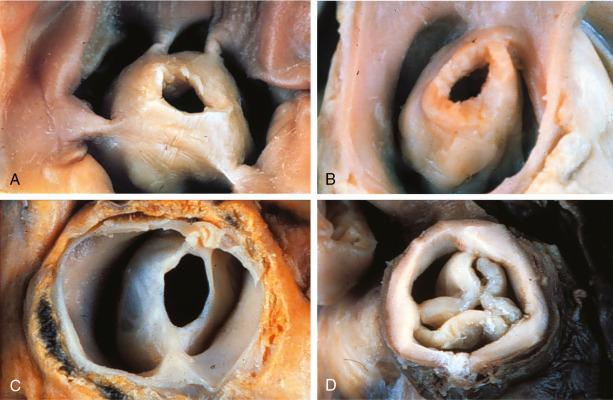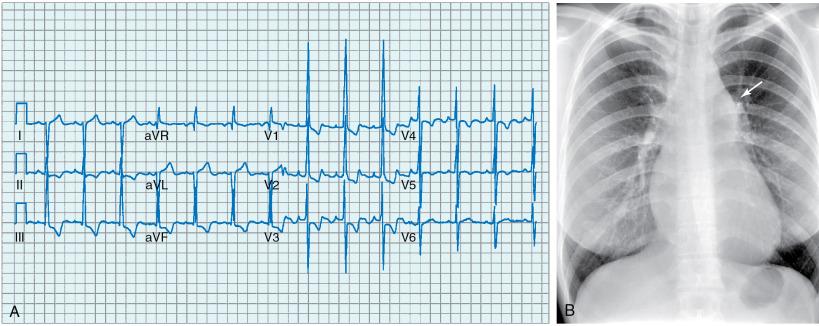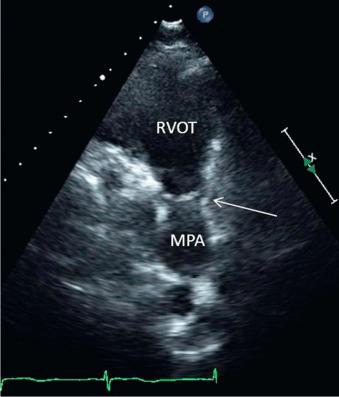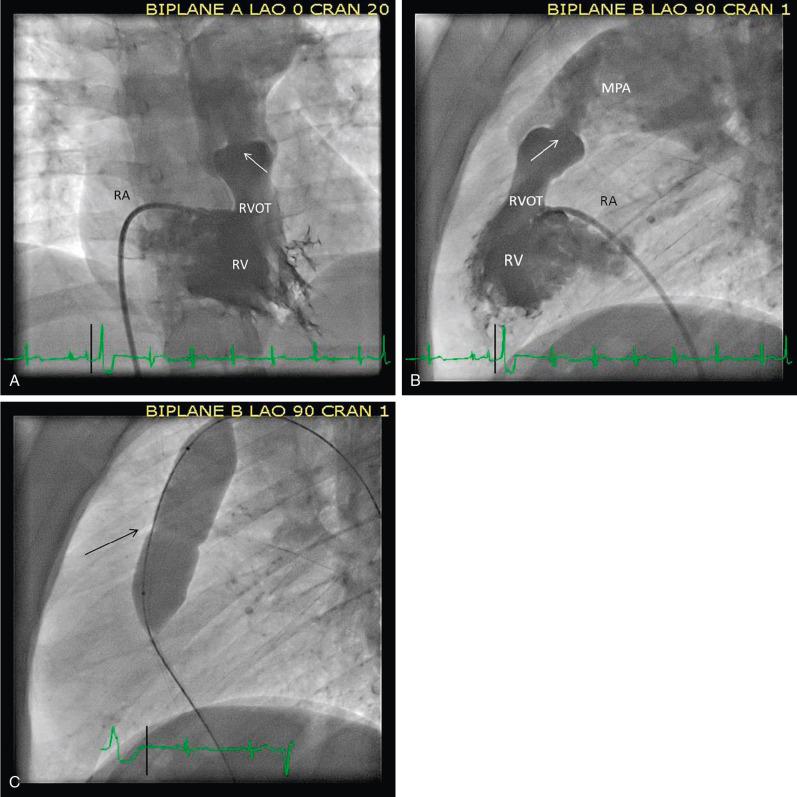Physical Address
304 North Cardinal St.
Dorchester Center, MA 02124
Congenital valvular pulmonic stenosis (PS) that is mild in severity is well tolerated and has a benign natural history.
Balloon angioplasty is the first-line treatment for severe valvular PS, especially for doming pulmonic valves.
Double-chambered right ventricle is an uncommon form of right ventricular outflow tract obstruction in which the right ventricle is divided into a proximal high-pressure and a distal low-pressure chamber. Surgical repair is effective and has low morbidity and mortality rates.
Supravalvular PS can involve the main and/or branch pulmonary arteries and may be associated with genetic syndromes. Repair of main pulmonary artery stenosis is often surgical, but percutaneous stenting may be an option for some, whereas catheter-based treatments are considered first-line treatment for peripheral pulmonary artery stenosis.
Repaired tetralogy of Fallot and valvular PS after surgical valvotomy are commonly associated with pulmonic regurgitation (PR), which can be tolerated for years or decades before symptoms manifest.
Cardiac magnetic resonance imaging (CMR) is the technique of choice for imaging tetralogy of Fallot, especially for quantification of PR and right ventricular size and function.
Indications for pulmonic valve replacement (PVR) are continuing to evolve and are based on symptoms, right ventricular size, and systolic function with a heavy reliance on CMR assessment.
PVR can improve symptoms but does not consistently improve right ventricular systolic function, and there are no data demonstrating a mortality benefit.
Transcatheter PVR has emerged as an alternative therapy for some patients, and rapidly evolving technologies hold promise for expanding eligibility to others. No head-to-head studies have directly compared surgical versus transcatheter approaches, but short- to medium-term outcomes regarding right ventricular remodeling and symptomatic improvement are similar.
Pulmonic valve disease in the adult is most commonly a congenital defect, but it also can manifest as part of an acquired condition such as rheumatic heart disease, carcinoid, or infective endocarditis, or it can result from trauma. Pulmonic regurgitation (PR) in an anatomically normal pulmonic valve can be caused by pulmonary hypertension or dilated pulmonary artery (PA) in Marfan syndrome. This chapter focuses on congenital diseases of the pulmonic valve, including tetralogy of Fallot (TOF).
The physiologic consequence of pressure overload to the right ventricle (RV) caused by pulmonic valve stenosis (PS) or by subvalvular pulmonic or supravalvular pulmonary stenosis is increased contractility and dilation that leads to increased wall stress and compensatory RV hypertrophy. Increased muscle mass enables the hypertrophied RV to maintain RV output. Severe hypertrophy leads to diminished compliance of the RV, resulting in increased RV end-diastolic pressure and right atrial pressure. Right-to-left shunting may occur if there is an interatrial communication. Over time, progressive RV hypertrophy and stiffness can give rise to RV diastolic dysfunction, which manifests as dyspnea or effort intolerance.
Volume overload to the RV from PR results in RV dilation, and there is a linear relationship between the degree of PR and RV end-diastolic volume. Increased RV end-diastolic volume allows for a compensatory increase in stroke volume to maintain cardiac output. Long-standing RV volume overload can result in RV diastolic dysfunction with elevation in RV end-diastolic pressure.
Although the conditions are physiologically distinct, lessons learned from the effects of chronic aortic regurgitation on the left ventricle (LV) suggest that chronic severe PR may follow a similar course. After an asymptomatic compensatory phase in which semilunar valve regurgitation is well tolerated for many years, there is a maladaptive phase consisting of progressive ventricular remodeling and eventually ventricular dysfunction that can be accompanied by symptoms. Dilation of the RV and the tricuspid annulus forms the substrate for functional tricuspid regurgitation, which compounds the volume overload.
PS is usually an isolated lesion; it occurs in approximately 8% to 10% of congenital heart disease cases and is the most common form of right-sided obstruction. The pulmonic valve is often dome shaped in systole with a narrow central opening and leaflet fusion; it can be calcified in older adults.
Pulmonic valve dysplasia is a less common form of PS; leaflets are thickened and poorly mobile, and there is no commissural fusion. It can be associated with a hypoplastic annulus and supravalvular PA narrowing. Dysplastic pulmonic valves are more often found in the setting of other cardiac and noncardiac anomalies. Unicuspid and bicuspid pulmonic valves rarely occur in isolation; they are usually found in complex congenital heart disease conditions such as TOF ( Fig. 24.1 ). PS is associated with genetic syndromes, including Noonan, Alagille, and Williams syndromes, and with congenital rubella ( Table 24.1 ).

| Genetic Syndrome | Genetic Defect | Cardiac Features | Noncardiac Features |
|---|---|---|---|
| Noonan | PTPN11 , SOS1 , RAF1 , RIT1 → aberrant RAS-MAPK signaling, autosomal dominant trait | Dysplastic pulmonic valve, supravalvular pulmonary stenosis, hypertrophic cardiomyopathy | Short stature, hypertelorism, micrognathia, high arched palate, low-set ears, webbed neck |
| Leopard (Noonan syndrome with multiple lentigines) | PTPN11 , RAF1 , BRAF , MAP2K1 , autosomal dominant trait | Hypertrophic cardiomyopathy, valvular pulmonic or supravalvular pulmonary stenosis | Lentigines, ocular hypertelorism, ptosis, pectus deformity, genital abnormalities, growth retardation, deafness |
| Williams | 7q11.23 deletion, autosomal dominant trait but most cases sporadic | Supravalvular aortic or pulmonic stenosis | Elfin facies, short stature, cognitive and developmental delay, endocrine disorders, genitourinary abnormalities |
| DiGeorge | 22q11.2 deletion, autosomal dominant trait but most cases sporadic | Conotruncal anomalies such as tetralogy of Fallot | Hypertelorism, low-set and posteriorly rotated ears, palatal abnormalities, micrognathia, developmental delay, hypoplastic thymus, hypocalcemia, immunologic and neuropsychiatric disorders |
| Alagille | JAG1 , NOTCH2 , autosomal dominant trait | Peripheral pulmonary stenosis, tetralogy of Fallot | Dysmorphic facies with triangular face, wide nasal bridge, deep-set eyes, intrahepatic cholestasis, butterfly vertebrae |
| Keutel | MGP mutations, autosomal recessive trait | Peripheral pulmonary stenosis | Abnormal cartilage calcifications, brachytelephalangia, intellectual disability, hearing loss |
| Congenital rubella | — | Peripheral pulmonary stenosis, patent ductus arteriosus | Congenital cataract/glaucoma, deafness, pigmentary retinopathy |
Valvular PS can be accompanied by aneurysmal dilation of the PA, with the poststenotic jet favoring the left PA. However, the degree of PA dilation is not necessarily related to the severity of PS. Most patients do not require operative repair unless there is PR resulting in RV dilation or symptoms attributable to compression of adjacent structures. The risk of dissection or rupture in the absence of pulmonary hypertension, left-to-right shunting, or connective tissue disorder is low, and conservative management is appropriate.
Most patients with PS are asymptomatic and come to attention when a murmur is auscultated. Symptoms rarely occur in childhood but become more common with age and severity of disease. Symptoms of moderate to severe PS include exercise intolerance and dyspnea resulting from inadequate augmentation of cardiac output with exertion and can progress to frank right-sided heart failure if not addressed. Exertional chest discomfort can arise from relative RV ischemia or coexistent coronary atherosclerosis. Rarely, patients can experience syncope or even sudden death due to ischemia from decreased myocardial perfusion of a hypertrophied RV and resultant arrhythmia. Desaturation can result from right-to-left shunting across an atrial-level communication, such as an atrial septal defect or patent foramen ovale.
Physical examination findings in the adult with valvular PS depends on the severity of the stenosis and any associated lesions. In mild PS, the jugular venous waveforms are normal, and the precordium is quiet. A systolic crescendo-decrescendo murmur is heard in the pulmonic position; it increases with inspiration and usually ends in mid-systole but can extend further with increasing severity of obstruction. There may be a pulmonic ejection click that decreases with inspiration. The second heart sound (S 2 ) is usually split.
In severe PS, the jugular venous pressure can be elevated with a prominent a wave. There may be an RV lift and a loud, harsh ejection murmur with associated thrill that radiates to the back. The degree of S 2 splitting is proportional to the degree of stenosis; it may be widely split and fixed. However, the pulmonic (P 2 ) component of the S 2 may be reduced or absent in severe stenosis, which can make splitting difficult to appreciate. A right-sided fourth heart sound (S 4 ) gallop may be auscultated.
The electrocardiogram (ECG) of PS is often normal in cases of mild disease, but with increasing severity the axis rotates rightward and features of RV hypertrophy and right atrial enlargement emerge. The chest radiograph typically demonstrates an enlarged main PA. The cardiac silhouette and vascularity are often normal in mild to moderate PS, but with severe PS cardiomegaly, right atrial enlargement, and decreased pulmonary vascular markings are seen ( Fig. 24.2 ).

Echocardiography is considered the mainstay of imaging valvular PS ( Fig. 24.3 ). The definition of severe valvular PS according to the 2018 American Hospital Association (AHA)/American College of Cardiology (ACC) guidelines for the management of adults with congenital heart disease is a maximum velocity (V max ) greater than 4 m/s or a peak instantaneous gradient greater than 64 mmHg, whereas mild PS is defined as a V max lower than 3 m/s or a peak instantaneous gradient lower than 36 mmHg ( Table 24.2 ).

| Assessment Measure | Mild | Moderate | Severe |
|---|---|---|---|
| Peak Doppler velocity (m/s) | <3 | 3–4 | >4 |
| Peak Doppler gradient (mmHg) | <36 | 36–64 | >64 |
| Mean Doppler gradient (mmHg) | — | — | >40 |
| RV systolic pressure/LV systolic pressure | <50% | 50%–74% | ≥75% |
Physiologic conditions that alter flow across the pulmonic valve affect the accuracy of gradient calculation by the modified Bernoulli equation. For example, if there is severe RV systolic dysfunction, the RV cannot generate sufficient pressure to overcome significant PS, yielding a peak instantaneous gradient that underestimates the true severity of the stenosis. Similarly, left-to-right flow across a septal defect or concomitant PR increases flow across the pulmonic valve, thereby increasing the transpulmonary gradient and overestimating the severity of pulmonic valve stenosis. Long-segment stenosis and serial obstructions (i.e., associated subvalvular PS and/or supravalvular PA stenosis) are other conditions in which Doppler-derived gradients are less reliable.
Peak instantaneous gradients measured by echocardiography overestimate peak-to-peak gradients in the catheterization laboratory and may be exaggerated by the effects of sedation. RV systolic pressure estimates based on tricuspid regurgitation peak velocity, qualitative assessment of septal position, and degree of RV hypertrophy can provide additional information on PS severity. Correlation between the Doppler gradient derived by echocardiography and clinical findings is recommended.
If there is a question, the gold standard in assessing the severity of valvular PS is cardiac catheterization, during which hemodynamic data, including pressure gradient across the pulmonic valve, RV systolic pressure compared with systemic pressure, and right-sided filling pressure, are obtained. In patients with normal cardiac output, mild stenosis is defined as a gradient lower than 35 to 40 mmHg or an RV pressure less than one half of the systemic pressure. Moderate stenosis is a gradient between 40 and 60 mmHg with RV pressure between one half and three fourths of the systemic pressure. Severe PS is defined as a gradient greater than 60 mmHg or an RV pressure equal to or greater than three fourths of the systemic pressure.
Angiography can demonstrate the morphologic characteristics of the pulmonic valve, including leaflet thickening, mobility and excursion, and leaflet tethering, as well as associated lesions, including annular hypoplasia, infundibular obstruction, and distal main or branch PA stenosis.
There are mixed data on the accuracy of peak instantaneous gradients derived by echocardiography compared with gradients obtained by invasive cardiac catheterization for PS. Some studies have demonstrated excellent correlation with peak-to-peak gradients, , whereas others have shown that peak instantaneous gradients overestimate peak-to-peak gradients but are comparable to catheter-derived maximal instantaneous gradients. , Mean Doppler gradients have the best correlation with peak-to-peak gradients in isolated and complex valvular PS.
Progression of mild PS is unusual after early childhood. The Second Natural History Study of Congenital Heart Defects demonstrated comparable survival rates for patients with mild PS and the general population, regardless of a medical or surgical management strategy, with most patients being asymptomatic. Those with a gradient between 25 and 49 mmHg had a 20% chance of needing an intervention, and most of those with gradients equal to or greater than 50 mmHg had progressive stenosis and required intervention.
Indications for intervention in valvular PS are summarized in Table 24.3 . Successful percutaneous balloon valvuloplasty was initially reported in 1982, and it is the treatment of choice for classic domed valvular PS ( Fig. 24.4 ). The mechanism for relief of stenosis is commissural splitting, and the outcomes are usually excellent. , Moreover, although the outcomes are not as optimal as with classic domed PS, balloon valvuloplasty may provide some degree of relief for dysplastic pulmonic valves and is a reasonable first-line option.
 |

A large, multicenter registry of 533 patients followed for a median of 33 months (range, 1 month to 8.7 years) after balloon valvuloplasty showed that 23% had suboptimal results, defined as a residual gradient of 36 mmHg or greater or repeat balloon valvuloplasty or surgical valvotomy. Predictors of suboptimal outcome included earlier study year of intervention, higher residual postprocedural gradient, and unfavorable valvular anatomy. Long-term outcomes were reported for 139 patients who underwent balloon valvuloplasty with a median follow-up of 6 years (range, 0–21 years); reintervention was required in only 9.4% of patients, mostly for restenosis. Mild PR is common, but moderate or greater PR can occur after balloon valvuloplasty and was observed in up to 60% of patients after a median follow-up of 15.1 years (range, 10.1–26.3 years). ,
Surgical relief of PS involves commissurotomy or valvotomy by an incision through the pulmonary trunk using an open or closed technique. Valvectomy is reserved for situations in which simple valvotomy is inadequate (i.e., dysplastic pulmonic valves). A transannular patch using autologous pericardium may be required to enlarge the annulus and supravalvular area. Outcomes of surgical valvotomy have demonstrated excellent survival rates of 90% to 96% up to 40 years after surgery but with a significant incidence of PR necessitating repeat surgical intervention (e.g., pulmonic valve replacement [PVR]) later in life.
Worsening of infundibular obstruction after relief of valvular PS by surgical valvotomy or balloon valvuloplasty is well documented, but this improves over time with regression of RV hypertrophy. , PR is not uncommon, especially after surgical intervention for valvular PS, and indications for PVR in cases of severe PR after surgical valvotomy are not well established. PVR may be appropriate in the setting of progressive RV dilation and dysfunction. , Management of residual PR is discussed later (see Tetralogy of Fallot ).
Become a Clinical Tree membership for Full access and enjoy Unlimited articles
If you are a member. Log in here